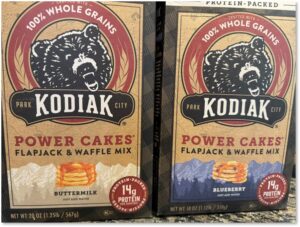“The food here is terrible
and such small portions.”
Woody Allen
Don’t be surprised if President Biden talks about shrinkflation in food prices at his State of the Union message on March 7. I wish my blog post on shrinkflation had brought it to his attention, but that medal really goes to Consumer Advocate Edgar Dworsky and Senator Bob Casey (D-PA).
High Prices / High Profits
 With inflation cooling, we can see more clearly the enormous profits posted by corporations. Many companies raised prices during the recovery from the pandemic. They attributed those increases to higher costs for the ingredients, materials and labor needed to provide their goods and services. Supply-chain problems in late 2021added to the price hikes. That gave them cover to raise prices higher than necessary.
With inflation cooling, we can see more clearly the enormous profits posted by corporations. Many companies raised prices during the recovery from the pandemic. They attributed those increases to higher costs for the ingredients, materials and labor needed to provide their goods and services. Supply-chain problems in late 2021added to the price hikes. That gave them cover to raise prices higher than necessary.
The resulting high cost of food has driven much of the dissatisfaction Americans feel with our economy. The stock market may go up, the unemployment may drop, salaries can rise—but people feel the inflation burn at the checkout counter. And we don’t like it.
Shrinkflation Increases
 By now, companies have ironed out those supply-chain and production problems and production costs have fallen much faster over the last year than the price of food on store shelves.
By now, companies have ironed out those supply-chain and production problems and production costs have fallen much faster over the last year than the price of food on store shelves.
The food industry has responded slowly. Prices remain high while shrinkflation increases. I bought these two boxes of Kodiak pancake and waffle mix at Target weeks apart. The one on the left has 20 ounces while the one on the right has only 18. Two ounces less; same price. That’s shrinkflation in a nutshell.
Companies rake in huge profit margins as consumers get squeezed. We know the pandemic is over, shelves are stocked, and the variety of brands has returned. The supermarkets look normal,and we have no trouble finding the products that we want.
Ripped Off and Mad as Hell
So, where does the problem lie? Given the situation, consumers have figured out the only remaining answer: price gouging. Prices stay high or go up even further. Package size goes down, and we’re getting shafted.
According to More Perfect Union, “Americans have to spend more of their money on food than they have in 30 years. Corporate price-gouging has driven up the cost of essential items, and it needs to be stopped.” We know the companies make those profits at our expense. And we don’t like that, either.
We all need to take a deep breath and say, “I’m mad as hell and I’m not going to take it anymore.” If you haven’t gotten angry by now, you’ll get there after reading Senator Casey’s shrinkflation report. It goes over grocery and household products category by category, illustrating by price and shrinkflation how we’re being ripped off.
As President Biden said in his Superbowl Sunday video, the American People do not want to be played for suckers.
Competition and Market Share
But what about competition? Why don’t companies take advantage of consumer dissatisfaction to gain market share from their competitors by lowering prices? Professor Robert Reich explains:
“Research has shown that nearly 80% of commonly purchased grocery items are supplied by just a handful of companies. The result? Corporations have the power to raise prices with impunity because consumers have so few options. Walmart hiked prices on its Great Value food brands. The result? $16.3 billion in earnings, up 44% from the prior year. Walmart also rewarded shareholders with $5.9 billion in buybacks and dividends.”
The five companies: Amazon, Walmart, Kroger, Albertson’s, and Ahold Delhaize, control dozens of other supermarkets across the United States. The current Kroger purchase of Albertson’s supermarkets will only make the situation worse. (The Federal Trade Commission has that merger under review and may block it.)
But for some products, at least, consumers have the option to just stop buying. As I said in my last post on shrinkflation, we can just forego purchasing non-essential products. People with limited grocery budgets and families to feed have no choice but to decline some purchases. If you spend all your money on meat, milk, eggs, produce and other essentials, you have nothing left for cookies, chips, candy, or soda. That means declining sales for these products.
Fighting Shrinkflation
And, guess what, it appears to be working.
The Wall Street Journal reported on February 20 (Page B1) that, “Shoppers are spending less per trip to Walmart for the first time in over two years, a sign that prices are cooling in some categories…” It also means that shoppers have stopped buying things they don’t need. The article continued, “Walmart’s executives said late last year that they were prepared to manage through a period of deflation and cut expenses if needed.”
 Companies have started paying attention, people.
Companies have started paying attention, people.
Consumers have begun, as I recommended, stepping back from products with high prices and smaller packages. With President Biden targeting shrinkflation as the cause of so much consumer dissatisfaction, it shines a spotlight on the price gouging companies have been getting away with under the cover of inflation.
Don’t let shrinkflation make you a sucker. Stop buying what you don’t need and keep up the good work. It will make a difference.
